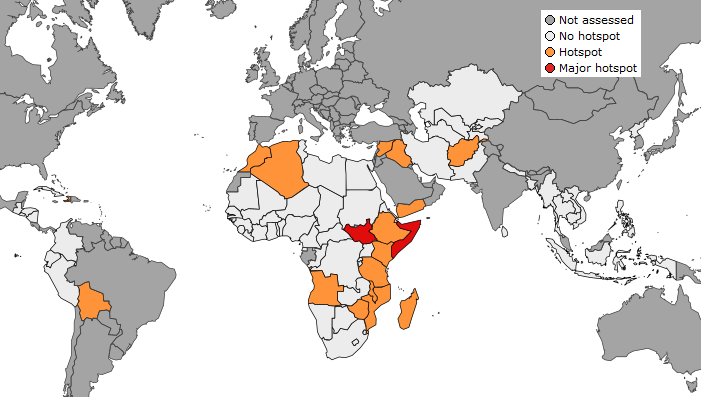
ASAP hotspot assessment March 2022
© EU 2022
The March edition of the JRC's Anomaly Hotspots of Agricultural Production (ASAP) assessment is now available at: Anomaly Hotspots of Agricultural Production (ASAP) assessment
Main findings of the March global overview:
- In Southern Africa, a rainfall deficit that started in February in central and eastern parts of the region, continued to affect the eastern part of the region at the beginning of March. Rainfall improved in mid-March, however tropical storms Ana and Gombe and October-December drought impacts are lowering national cereal productions. On the contrary, an above-average output is forecast in South Africa, in Eswatini and Lesotho.
- In East Africa, there is increasing concern that the region will experience the fourth consecutive poor rainfall season during March-May 2022 rains. Cumulated Copernicus C3S multi-model rainfall forecasts for April-June show a high probability of a drier than average period for the Horn and wetter than average conditions for South Sudan, Western Kenya, Ethiopian Highlands and Uganda. The pressure on food security caused by the exceptionally prolonged drought appears even more threatening with the increase in food prices and the challenges of small-scale farmers to access fertiliser. A high number of people in the region (45-55 million) need humanitarian food and nutrition assistance to prevent Crisis or worse outcomes between January and May 2022 (FEWSNET).
- In North Africa, the winter cereal season is suffering from drought stress and rainfall in March came in most cases too late for crop recovery. In Morocco and in western Algeria reduced yields can be expected (see more on yield forecasts in the latest MARS bulletin). A low winter wheat production in one or more countries in North Africa is of particular concern with the expected food price inflation linked to Russia’s invasion of Ukraine. Similarly, in the Middle East, prospects for winter cereals are poor in the north of Syria and north and east of Iraq due to poor rainfall and poor socio-economic conditions since autumn 2021. In contrast, biomass of winter crops is still close to average in Iran and in Yemen land preparation is ongoing under favourable conditions.
- In West Africa, land preparation and sowing activities for the first maize season are starting in the southern bimodal parts of the region along the coast of the Gulf of Guinea with the onset of seasonal rains in March. Rainfall conditions were average over the past month; however slightly below-average vegetation conditions are observed in southern Nigeria, Togo, Ghana and parts of Cote d’Ivoire. The food security situation is very deteriorated in the region with about 38.3 million people forecast to be in crisis (CH Phase 3) and above by June-August 2022 if no action is taken according to the latest CH analyses in March 2022 (PREGEC communique-March 2022).
- In Central Asia, biomass of winter crops is close to or above-average, however with below-average rainfall forecast for the next 3 months, irrigation will be critical for crop production. In Afghanistan, biomass of winter cereals is close to average in most regions, however a very large part of the population (up to 95%) suffers from food insecurity. In South Asia, prospects are favourable for Rabi crops (winter cereals) and Boro rice in Pakistan and Bangladesh respectively. In Sri Lanka, harvest of main season (Maha) rice and maize has been finalised with close to average prospects; however, fertiliser and fuel shortages are likely to decrease production.
- In South-East Asia, dry season rice is growing under favourable conditions and prospects are positive. In Indonesia, wet season rice planted from November to March is in good condition thanks to favourable rainfall.
- In Central America, harvest of third season maize-beans (Apante-Postrera tardia) concluded with average production for the region (). The overall 2021 cereal production is close to the 5-year average, with Honduras and Nicaragua slightly below. Total cereal output is estimated below the 5-year average for Haiti. Land preparation has started for the main season in Guatemala and Honduras, whereas rice is in the growing stage in Nicaragua (irrigated-main) and in Honduras (second season). In the Caribbean, sowing of main season maize and rice has started under favourable conditions, except in parts of Cuba.
Sources
Details
- Publication date
- 8 April 2022
- Author
- Joint Research Centre
